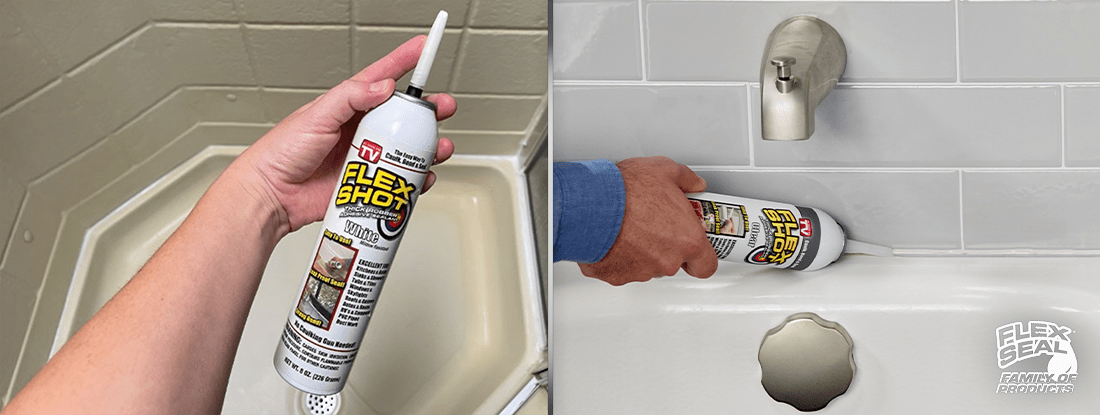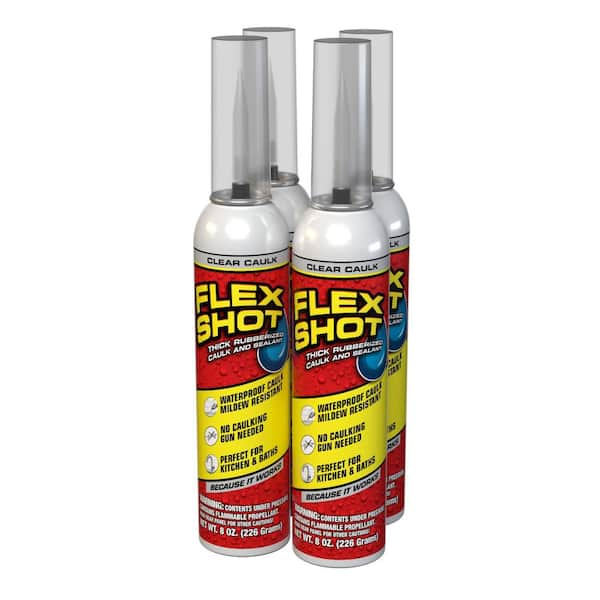Flex Shot and silicone caulk are both sealants, but Flex Shot is known for its flexibility, durability, and easy application. Silicone caulk, on the other hand, is a traditional sealant that provides a strong bond but may require more effort to apply and may not be as flexible.
Each product has its own advantages and best uses depending on the specific project requirements. Let’s take a closer look at the characteristics and uses of Flex Shot and silicone caulk to determine which one is the right choice for your sealing needs.
Introduction To Sealants
Sealants play a vital role in home repairs. They act as a barrier to prevent air, water, and moisture from entering a building. There are various types of sealants available in the market, including silicone caulk and Flex Shot. Silicone caulk is a traditional sealant that is widely used because of its durability and flexibility. On the other hand, Flex Shot is a newer sealant that claims to be easier to apply and more versatile than traditional caulk. Both sealants have their pros and cons, and the choice between the two depends on the specific needs of the project. It is essential to understand the differences between the two sealants before deciding which one to use.
| Popular Types of Sealants | Pros | Cons |
|---|---|---|
| Silicone Caulk | Durable, flexible, and resistant to moisture and weathering | Difficult to apply, requires a longer curing time, and may crack over time |
| Flex Shot | Easy to apply, versatile, and dries quickly | May not be as durable as silicone caulk and may shrink over time |

Flex Shot: A Revolutionary Product
Flex Shot is a revolutionary product designed for easy and efficient sealing and caulking. It is a versatile sealant that can be used for a variety of applications, including sealing leaks and cracks. The key features of Flex Shot include its easy application, quick drying time, and durability. It provides a waterproof and flexible seal, making it ideal for both indoor and outdoor use.
One of the main advantages of Flex Shot is its ability to adhere to a wide range of surfaces, including wood, metal, glass, and tile. It is also resistant to extreme temperatures, making it suitable for use in all seasons. However, some potential drawbacks of Flex Shot include its limited color options and the need for proper surface preparation before application.
Silicone Caulk: The Traditional Choice
Silicone caulk has been a popular choice for sealing and bonding applications for many years. It is known for its durability and flexibility, making it ideal for a wide range of projects. Silicone caulk offers several key characteristics that set it apart from other sealants.
Advantages:
- Durability: Silicone caulk is resistant to moisture, UV rays, and extreme temperatures, ensuring long-lasting performance.
- Flexibility: It can accommodate movement and expansion without cracking or losing its seal, making it suitable for various substrates.
- Adhesion: Silicone caulk forms a strong bond to different materials, including glass, metal, and ceramics.
- Waterproof: It provides an effective barrier against water infiltration, preventing leaks and water damage.
Limitations:
- Curing Time: Silicone caulk typically requires a longer curing time compared to other sealants, delaying the completion of projects.
- Paintability: It is not suitable for direct paint application, requiring additional steps such as priming or using specific paint formulas.
- Cost: Silicone caulk tends to be more expensive than alternative options, which may impact budget-conscious projects.

Comparative Analysis
In the comparative analysis of Flex Shot vs silicone caulk, Flex Shot offers a quick and easy application, with no need for a caulking gun. On the other hand, silicone caulk provides a durable and waterproof seal, making it suitable for high-moisture areas.
Both options have their unique benefits for different sealing needs.
| Flex Shot | Silicone Caulk |
| Easy to apply with precision due to its convenient cartridge design. | Application requires a caulking gun, making it a bit more challenging for precision work. |
| Forms a strong, waterproof seal that lasts for years without cracking or shrinking. | Known for its durability, offering long-lasting waterproof sealing. |
| Can be used for a wide range of sealing and bonding applications indoors and outdoors. | Primarily used for sealing gaps and joints in kitchens, bathrooms, and other wet areas. |
Water Resistance Showdown
Flex Shot and Silicone Caulk are both used for water resistance, but which one is better? In this showdown, we compare the two products and evaluate their effectiveness.
| Flex Shot | Silicone Caulk |
|---|---|
| Forms a watertight seal | Known for its water-repellent properties |
| Resistant to water exposure | Provides excellent resistance to water |
| Designed to withstanding water | Offers long-lasting water resistance |
Adhesion And Flexibility
Flex Shot and silicone caulk are both adhesives used for sealing purposes, but Flex Shot stands out due to its flexibility. While silicone caulk can become brittle over time, Flex Shot remains pliable and can expand and contract with temperature changes, making it a more durable option.
| Flex Shot | Silicone Caulk |
| Excellent adhesion and flexibility | Good adhesion, but less flexible |
| Strong bonding strength | Comparatively weaker bonding |
| Can adapt well to temperature changes | Susceptible to temperature variations |
Curing Time And Ease Of Use
Flex Shot and silicone caulk both offer a quick curing time, allowing for efficient use. With their ease of application, these products provide a hassle-free experience, making them suitable for various sealing and bonding projects. Their user-friendly nature ensures convenience and effectiveness in completing tasks.
| Flex Shot | Silicone Caulk |
| Quick curing time | Slower curing dynamics |
| Easy to use | Requires precision in application |
Cost Considerations
When considering cost, it’s important to weigh the benefits of Flex Shot versus silicone caulk. Flex Shot may be more expensive initially, but its durability often leads to cost savings in the long run. Silicone caulk, while cheaper upfront, may require more frequent replacement.
| Cost Considerations |
| Flex Shot offers competitive pricing for its products, making it a cost-effective choice. Silicone caulk, on the other hand, is known for its affordability and widely available in the market. |
Environmental And Health Factors
Comparing Flex Shot and silicone caulk considers both environmental and health factors. Flex Shot, being non-toxic and eco-friendly, offers a safer alternative compared to traditional silicone caulk. The impact on indoor air quality and potential health risks are important considerations when choosing between the two options.
| Eco-Friendliness of Products | Safety for Indoor Use |
| Flex Shot is known for its environmentally friendly formula, making it a preferred choice for eco-conscious consumers. | Silicone caulk, on the other hand, may emit strong odors, posing health risks in enclosed spaces. |
| Flex Shot‘s non-toxic composition ensures minimal impact on indoor air quality. | Choosing a product like Flex Shot can help maintain a safer indoor environment. |
Consumer Reviews And Feedback
| Consumer Reviews and Feedback |
|
Many customers have shared their experiences with Flex Shot and Silicone Caulk. Users praised Flex Shot for its ease of use and flexibility, making it ideal for various applications. The majority found it durable and long-lasting. In contrast, Silicone Caulk users appreciated its waterproof properties and strong adhesion. Some reported that it requires more effort to apply compared to Flex Shot. However, others mentioned that Silicone Caulk‘s versatility and mold resistance were its standout features. Both products have garnered a mix of positive and negative reviews, highlighting the importance of considering individual needs and preferences. |
Final Verdict
Flex Shot and Silicone Caulk are both versatile sealants, each with its own strengths. Flex Shot is ideal for quick fixes and small projects, offering easy application and a mess-free experience. On the other hand, Silicone Caulk provides a more durable and long-lasting seal, making it suitable for larger and more permanent projects. When deciding between the two, it’s important to consider the specific needs of your project. For quick repairs or temporary fixes, Flex Shot may be the better option, while larger, permanent projects may benefit from the durability of Silicone Caulk. Ultimately, the choice between Flex Shot and Silicone Caulk depends on the specific requirements of the project at hand.

Faqs On Flex Shot And Silicone Caulk
Q: Can Flex Shot be used to fill large gaps?
A: Yes, Flex Shot is designed to fill large gaps effectively. Its thick, rubberized formula allows it to expand and contract, providing a durable seal.
Q: Is silicone caulk better for bathroom applications?
A: Silicone caulk is commonly recommended for bathroom applications due to its resistance to moisture and mildew. It offers a long-lasting seal in wet environments.
Q: How long does it take for Flex Shot and silicone caulk to dry?
A: The drying time varies depending on factors such as humidity and temperature. Generally, Flex Shot takes around 24-48 hours to fully cure, while silicone caulk may require 48-72 hours.
Q: Can Flex Shot and silicone caulk be painted over?
A: Yes, both Flex Shot and silicone caulk can be painted over once fully cured. It is important to use a paint that is compatible with the specific caulk or sealant being used.
Q: Can Flex Shot and silicone caulk be used on different surfaces?
A: Flex Shot and silicone caulk can be used on various surfaces such as wood, metal, glass, and ceramic. However, it is recommended to read the product instructions for specific surface compatibility.
Q: Which one is easier to apply, Flex Shot or silicone caulk?
A: Both Flex Shot and silicone caulk are relatively easy to apply. Flex Shot comes in a convenient can with a nozzle for precise application, while silicone caulk requires a caulk gun for application.
Q: Are there any safety precautions to consider when using Flex Shot or silicone caulk?
A: It is important to follow the safety instructions provided by the manufacturers. These may include wearing protective gloves and ensuring proper ventilation when working with the products.
Frequently Asked Questions
Is Flex Shot Better Than Silicone Caulk?
Flex Shot and silicone caulk have their own advantages and disadvantages. Flex Shot is easier to apply and provides a stronger seal, while silicone caulk is more durable and has a longer lifespan. It ultimately depends on the project’s needs and the user’s preferences.
Can Flex Shot Be Used On Outdoor Projects?
Yes, Flex Shot is suitable for outdoor use. It is weather-resistant and can withstand extreme temperatures, making it ideal for sealing gaps and cracks in outdoor projects such as gutters, windows, and doors.
How Long Does It Take For Flex Shot To Dry?
The drying time of Flex Shot varies depending on the humidity and temperature of the environment. It usually takes around 24-48 hours to fully dry, but it can take longer in colder temperatures or more humid conditions.
Can Silicone Caulk Be Painted Over?
Yes, silicone caulk can be painted over once it has fully cured. However, it is important to use a paintable silicone caulk and wait for it to fully dry before painting to ensure the best results.
Conclusion
When comparing Flex Shot and silicone caulk, it is clear that both products have their advantages and disadvantages. Flex Shot offers the convenience of a ready-to-use, easy application, while silicone caulk provides a long-lasting and watertight seal. Ultimately, the choice between the two depends on the specific project and desired outcomes.
Regardless of the option chosen, ensuring proper preparation and application techniques will result in a successful sealing job. Happy caulking!
